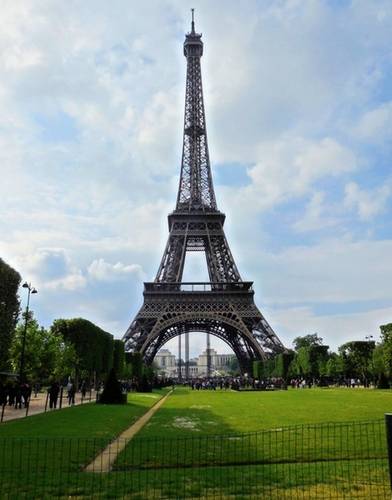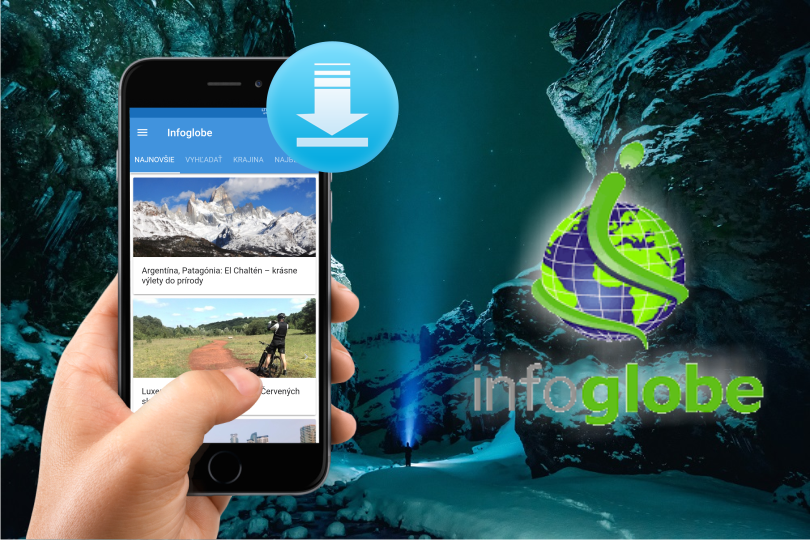Eiffel tower in Paris

This biggest bulding of the world - (at the end of 19th century) - was constructed in a period between 1887-1889, in order to create entrance gate for World Exhibition, taken place on occasion of 100th anniversary of Great French Revolution. Originally, Eiffel planned to construct this tower in Barcelona, for World Exhibition, arranged in 1888. However, this building was for conservative Barcelona society circles incomprehensible, „strange“, and was not suitable for town´s architectonical colourite. Nevertheless, Gustave Eiffel managed to carry out the suggestion of his building to representatives of Paris. So, on 6th May 1889, he could be present on occasion of its ceremonial opening.
From the very beginning, the tower had to oppose a wave of strong public criticism. So, for instance, writer Guy de Maupassant affirmed that he did not stand that building when he took his meal in tower´s restaurant. When he was asked for the reason, he replied that this was the only place in Paris, from here he could not see this tower.
It is quite interesting that one of traditional Hollywood customs is an assertion that each Paris citizen has the possibility to see Eiffel Tower from his window. Nevertheless, most of all buildings in Paris has its height limited for seven floors only, so the tower could be seen from little number of top (roofs) of buildings.
The tower had a permission for its existence for a period of 20 years, and it would be taken to pieces in 1909. Anyway, Eiffel Tower proved to be very valued for purposes of communication. The army used it, in order to instigate taxi-drivers for front line, during first Marne-battle.
Within time-period when the tower was constructed, many people were shocked with its courageous form. However, Eiffel was criticised for a fact that he tried to create something of „artistic style“, irrespective of machinery. But he and his engineers were conscious of wind -strength danger in high heights. So, it was necessary to suggest construction of the tower in such way, in order to resist such type of danger. There was stipulated exponential form of tower (this is most powerful in lower parts of tower against strong winds) by means of mathematics calculation.
Some facts about Eiffel Tower:
 Height (from earth up to mast top): 312 metres
Height (from earth up to mast top): 312 metres
Actual height (including aerial antenna): 324 metres
Weight: 10000 tonns
Weight of metal construction: 7300 tonns
Number of bulbs, illuminating the tower: 20000 pieces
Number of rivets: 2500000 pieces
Colours consumption: 60 tonns for each painting over, which is effected every seventh year
Number of lifts: from groundfloor up to the second stage: 5, from second stage up to the top: 2
Lift speed: 2 m/sec.
Number of visitors (till 31st December 2008): 243 376 000
Electricity consumption: 7,8 millions kWh per one year it is equal for consumption in a village of 100 houses capacity
Gustave Eiffel
He was born in Dijon on 15th December 1932. He studied in prestige school Ecole Central in Paris. His immense career started in 1876 with Maria Pia bridge construction across Douro, river in Portugal. In 1884, he constructed a viaduct in central France and railway station building in Budapest, Hungary. He also was in charge of metal construction of Bon Marche department store and Credit Lyonnaise Bank building in Paris, further, he suggested a cupola of observatory in Nice, and, last but not least, also imposing internal structure of Liberty Statue in United States. And, afterthat, in 1889, it came a top of his working activity - Tower in Paris. After failure of Panama Canal project, he started to be busy with experiments, regarding air - resistance, meteorology, and he also assisted at installation of gigantic radio antenne.
Inventions effected at the end of 19th century:
The end of 19th century brought great number of inventions, which completely changed our lives within long-term perspective. So, let´s have a look at some of them, as follows:
1876-1877: four-cylindrical motor (Gottlieb Daimler, Nicolas Otto, Maybach)
1876: writing machine (Philo Remington)
1876: telephone apparatus (Alexander G. Bell)
1877: phonograph (in France, investigated by Charles Cros, in USA later Thomas A.Edison)
1879: electric bulb (T.A.Edison) and electric locomotive (Werner von Siemens)
1881: there was investigated a car, driven by steam, named La Rapide (Amedee Bollee).
1884: fountain pen (Lewis E.Waterman)
1885: vaccination against hydrophobia (Louis Pasteur)
1886: first electric lamps in Paris
1887: start of Eiffel Tower construction in Paris
1888: Kodak came to France, and Henry Hertz discovered (invented) electromagnetic waves.
1889: transparent photographic film made from nitrocellulose (George Eastmann)
1890: Etienne J.Marey presented chronography on moving film
1891: Edouard Michelin presented first changeble tyres for bicycles, for cars were adapted later, in 1894.
1894-1903: effected first car races on road
1895: X-rays discovered (William Roentgen)
1896: radio-activity in uranium salts discovered (Henry Becquerel).
1897: first wireless phone transmission effected (Edouard Branlia, William Marconi)
1898: first telegraphic connection between Pantheon and Eiffer Tower (Eugene Ducretet and Ernest Roger), discovery of radium (Pierre and Mary Curie)
1899: first wireless communication across La Manche Channel (William Marconi)
1900: During World Exhibition in Paris, underground (tube) and air-ship presented (Count Ferdinand von Zeppelin).
Text: Maxim Kucer
Photo: Oskár Mažgút
| Discussion at the article (0) |
Related Articles

Versailles - window of France

France, Paris XIX: The Eiffel Tower and Surroundings

France, Paris XVI – Montmartre: Place for Saints and Sins

France, Paris XV – Montmartre: City Greatly Visible

France, Paris XVII: Tour Montparnasse – Experience of a Lifetime

France, Paris XIII. – Versailles, the Place of French Pride II

France, Paris XII. – Versailles, Place of French Pride I

France, Paris XX: Eiffel Tower and Its Surroundings II

France, Paris VII. – Square Around Center Pompidou

France, Paris II. – City of the Famous and the Wise

France, Paris III – History Embraced in Greenery

Gardens in Paris

Romantic Paris

France, Paris VII. – Square Around Center Pompidou

France, Paris IV – On a Way to Notre Dame

France, Paris VI. – Architecture Beloved and Condemned

France, Paris IX. – Royal Walk to the River

France, Paris XVIII: Paris Underground - Métropolitain

France, Paris V. – Noble Notre Dame Cathedral

France, Paris XIV. - La Défense: Gem of Modernism

France, Paris I – City of Eternal Beauty

France, Paris X. – DOrsay Museum, the Home of Impressionism

France, Paris XI. – Seine, the River of Life
Guide:
Important Information:
![]() Information and warnings on travelling abroad is to be found HERE.
Information and warnings on travelling abroad is to be found HERE.





























